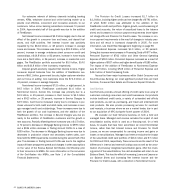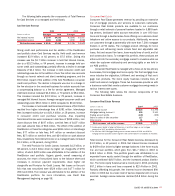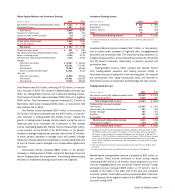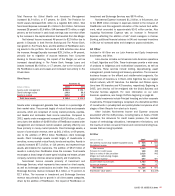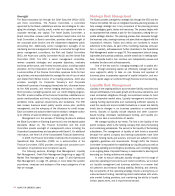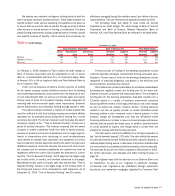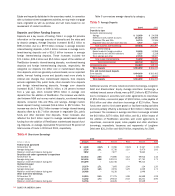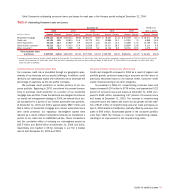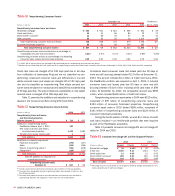Bank of America 2004 Annual Report Download - page 53
Download and view the complete annual report
Please find page 53 of the 2004 Bank of America annual report below. You can navigate through the pages in the report by either clicking on the pages listed below, or by using the keyword search tool below to find specific information within the annual report.
52 BANK OF AMERICA 2004
Oversight
The Board evaluates risk through the Chief Executive Officer (CEO)
and three committees. The Finance Committee, a committee
appointed by the Board, establishes policies and strategies for man-
aging the strategic, liquidity, credit, market and operational risks to
corporate earnings and capital. The Asset Quality Committee, a
Board committee, reviews credit and selected market risks; and the
Audit Committee, a Board committee, provides direct oversight of
the corporate audit function and the independent registered public
accounting firm. Additionally, senior management oversight of our
risk-taking and risk management activities is conducted through three
senior management committees: the Risk and Capital Committee
(RCC), the Asset and Liability Committee (ALCO) and the Credit Risk
Committee (CRC). The RCC, a senior management committee,
reviews corporate strategies and corporate objectives, evaluates
business performance, and reviews business plans, including capital
allocation, for the Corporation and for major businesses. The ALCO,
a subcommittee of the Finance Committee, approves limits for trad-
ing activities, and was established to manage the risk of loss of value
and related Net Interest Income of our trading positions. ALCO also
provides oversight for Corporate Treasury’s and Corporate
Investment’s process of managing interest rate risk, otherwise known
as the ALM process, and reviews hedging techniques. In addition,
ALCO provides oversight guidance over our credit hedging program.
The CRC, a subcommittee of the Finance Committee, establishes cor-
porate credit practices and limits, including industry and country con-
centration limits, approval requirements and exceptions. The CRC
also reviews business asset quality results versus plan, portfolio
management, and the adequacy of the allowance for credit losses.
Each committee and subcommittee has the ability to delegate author-
ity to officers of subcommittees to manage specific risks.
Management is in the process of finalizing its plans to address
the Basel Committee on Banking Supervision’s new risk-based capital
standards (Basel
II
). The Finance Committee and the Audit
Committee provide oversight of management’s plans including the
Corporation’s preparedness and compliance with Basel
II
. For additional
information, see Note 14 of the Consolidated Financial Statements.
In 2005, the Finance Committee chartered the Compliance and
Operational Risk Committee (CORC) as a subcommittee of the
Finance Committee. CORC provides oversight and consistent com-
munication of operational and compliance issues.
The following sections, Strategic Risk Management, Liquidity
Risk Management, Credit Risk Management beginning on page 58,
Market Risk Management beginning on page 72 and Operational
Risk Management on page 78, address in more detail the specific
procedures, measures and analyses of the major categories of risk
that we manage.
Strategic Risk Management
The Board provides oversight for strategic risk through the CEO and the
Finance Committee. We use an integrated business planning process to
help manage strategic risk. A key component of the planning process
aligns strategies, goals, tactics and resources. The process begins with
an assessment that creates a plan for the Corporation, setting the cor-
porate strategic direction. The planning process then cascades through
the business units, creating business unit plans that are aligned with the
Corporation’s direction. Tactics and metrics are monitored to ensure
adherence to the plans. As part of this monitoring, business units per-
form a quarterly self-assessment further described in the Operational
Risk Management section on page 78. This assessment looks at chang-
ing market and business conditions, and the overall risk in meeting objec-
tives. Corporate Audit in turn monitors, and independently reviews and
evaluates the plans and self-assessments.
One of the key tools for managing strategic risk is capital allo-
cation. Through allocating capital, we effectively manage each busi-
ness segment’s ability to take on risk. Review and approval of
business plans incorporates approval of capital allocation, and eco-
nomic capital usage is monitored through financial and risk reporting.
Liquidity Risk Management
Liquidity is the ongoing ability to accommodate liability maturities and
deposit withdrawals, fund asset growth and business operations, and
meet contractual obligations through unconstrained access to fund-
ing at reasonable market rates. Liquidity management involves fore-
casting funding requirements and maintaining sufficient capacity to
meet the needs and accommodate fluctuations in asset and liability
levels due to changes in our business operations or unanticipated
events. Sources of liquidity include deposits and other customer-
based funding, wholesale market-based funding, and liquidity pro-
vided by the sale or securitization of assets.
We manage liquidity at two levels. The first is the liquidity of the
parent company, which is the holding company that owns the banking
and nonbanking subsidiaries. The second is the liquidity of the banking
subsidiaries. The management of liquidity at both levels is essential
because the parent company and banking subsidiaries each have
different funding needs and sources, and each are subject to certain
regulatory guidelines and requirements. Through ALCO, the Finance
Committee is responsible for establishing our liquidity policy as well as
approving operating and contingency procedures, and monitoring liquidity
on an ongoing basis. Corporate Treasury is responsible for planning and
executing our funding activities and strategy.
In order to ensure adequate liquidity through the full range of
potential operating environments and market conditions, we conduct
our liquidity management and business activities in a manner that
will preserve and enhance funding stability, flexibility, and diversity.
Key components of this operating strategy include a strong focus on
customer-based funding, maintaining direct relationships with whole-
sale market funding providers, and maintaining the ability to liquefy
certain assets when, and if requirements warrant.


